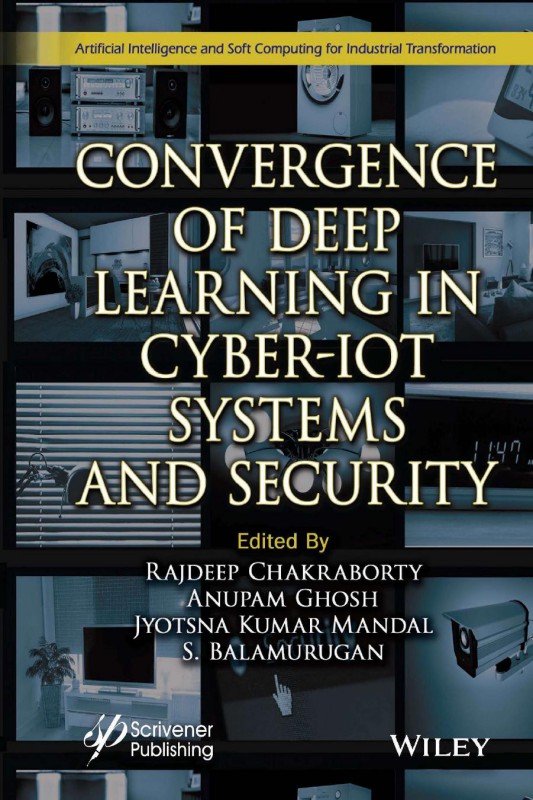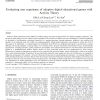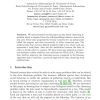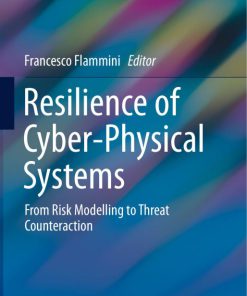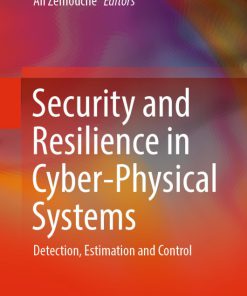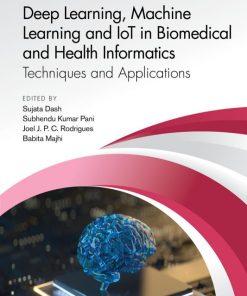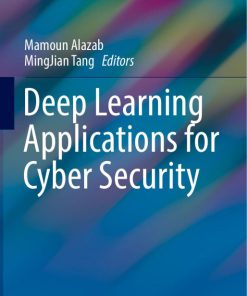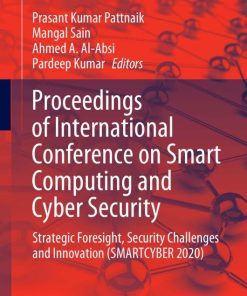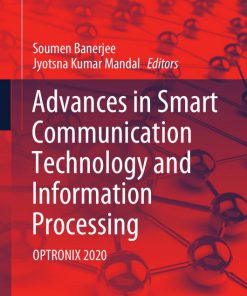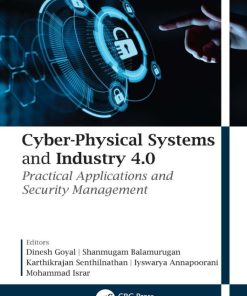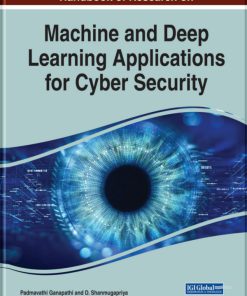Convergence of Deep Learning in Cyber-IoT Systems and Security 1st edition by Rajdeep Chakraborty, Anupam Ghosh, Jyotsna Kumar Mandal, Balamurugan 111985766X 9781119857662
$50.00 Original price was: $50.00.$25.00Current price is: $25.00.
Authors:Chakraborty, Rajdeep;Ghosh, Anupam;Mandal, Jyotsna Kumar;Balamurugan, S.; , Series:Cyber Security [357] , Author sort:Chakraborty, Rajdeep;Ghosh, Anupam;Mandal, Jyotsna Kumar;Balamurugan, S.; , Languages:Languages:eng , Published:Published:Sep 2022 , Publisher:Wiley
Convergence of Deep Learning in Cyber-IoT Systems and Security 1st edition by Rajdeep Chakraborty, Anupam Ghosh, Jyotsna Kumar Mandal, S. Balamurugan – Ebook PDF Instant Download/DeliveryISBN: 111985766X, 9781119857662
Full download Convergence of Deep Learning in Cyber-IoT Systems and Security 1st edition after payment.
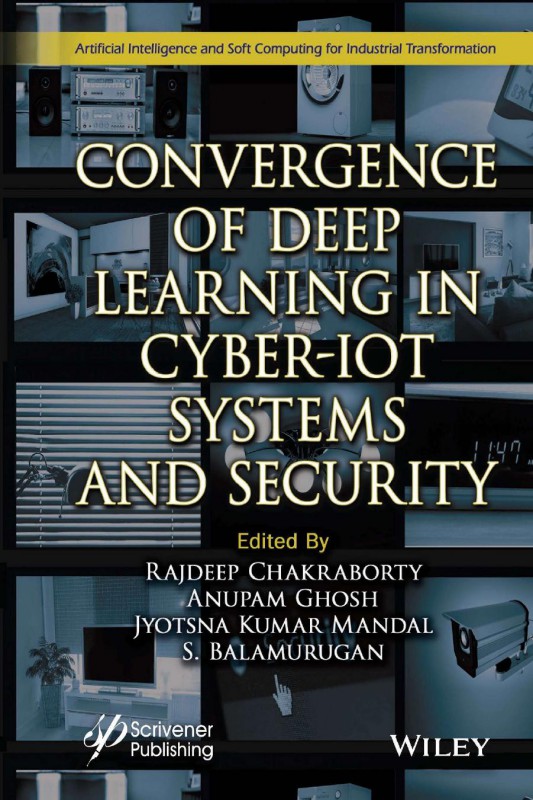
Product details:
ISBN-10 : 111985766X
ISBN-13 : 9781119857662
Author : Rajdeep Chakraborty, Anupam Ghosh, Jyotsna Kumar Mandal, S. Balamurugan
CONVERGENCE OF DEEP LEARNING IN CYBER-IOT SYSTEMS AND SECURITY
In-depth analysis of Deep Learning-based cyber-IoT systems and security which will be the industry leader for the next ten years.
The main goal of this book is to bring to the fore unconventional cryptographic methods to provide cyber security, including cyber-physical system security and IoT security through deep learning techniques and analytics with the study of all these systems.
Convergence of Deep Learning in Cyber-IoT Systems and Security 1st Table of contents:
Part I: VARIOUS APPROACHES FROM MACHINE LEARNING TO DEEP LEARNING
1 Web-Assisted Noninvasive Detection of Oral Submucous Fibrosis Using IoHT
1.1 Introduction
1.2 Literature Survey
1.3 Primary Concepts
1.4 Propose Model
1.5 Comparative Study
1.6 Conclusion
References
2 Performance Evaluation of Machine Learning and Deep Learning Techniques: A Comparative Analysis for House Price Prediction
2.1 Introduction
2.2 Related Research
2.3 Research Methodology
2.4 Experimentation
2.5 Results and Discussion
2.6 Suggestions
2.7 Conclusion
References
3 Cyber Physical Systems, Machine Learning & Deep Learning—Emergence as an Academic Program and Field for Developing Digital Society
3.1 Introduction
3.2 Objective of the Work
3.3 Methods
3.4 Cyber Physical Systems: Overview with Emerging Academic Potentiality
3.5 ML and DL Basics with Educational Potentialities
3.6 Manpower and Developing Scenario in Machine Learning and Deep Learning
3.7 DL & ML in Indian Context
3.8 Conclusion
References
4 Detection of Fake News and Rumors in Social Media Using Machine Learning Techniques With Semantic Attributes
4.1 Introduction
4.2 Literature Survey
4.3 Proposed Work
4.4 Results and Analysis
4.5 Conclusion
References
Part II: INNOVATIVE SOLUTIONS BASED ON DEEP LEARNING
5 Online Assessment System Using Natural Language Processing Techniques
5.1 Introduction
5.2 Literature Survey
5.3 Existing Algorithms
5.4 Proposed System Design
5.5 System Implementation
5.6 Conclusion
References
6 On a Reference Architecture to Build Deep-Q Learning-Based Intelligent IoT Edge Solutions
6.1 Introduction
6.2 Dynamic Programming
6.3 Deep Q-Learning
6.4 IoT
6.5 Conclusion
6.6 Future Work
References
7 Fuzzy Logic-Based Air Conditioner System
7.1 Introduction
7.2 Fuzzy Logic-Based Control System
7.3 Proposed System
7.4 Simulated Result
7.5 Conclusion and Future Work
References
8 An Efficient Masked-Face Recognition Technique to Combat with COVID-19
8.1 Introduction
8.2 Related Works
8.3 Mathematical Preliminaries
8.4 Proposed Method
8.5 Experimental Results
8.6 Conclusion
References
9 Deep Learning: An Approach to Encounter Pandemic Effect of Novel Corona Virus (COVID-19)
9.1 Introduction
9.2 Interpretation With Medical Imaging
9.3 Corona Virus Variants Tracing
9.4 Spreading Capability and Destructiveness of Virus
9.5 Deduction of Biological Protein Structure
9.6 Pandemic Model Structuring and Recommended Drugs
9.7 Selection of Medicine
9.8 Result Analysis
9.9 Conclusion
References
10 Question Answering System Using Deep Learning in the Low Resource Language Bengali
10.1 Introduction
10.2 Related Work
10.3 Problem Statement
10.4 Proposed Approach
10.5 Algorithm
10.6 Results and Discussion
10.7 Analysis of Error
10.8 Few Close Observations
10.9 Applications
10.10 Scope for Improvements
10.11 Conclusions
Acknowledgments
References
Part III: SECURITY AND SAFETY ASPECTS WITH DEEP LEARNING
11 Secure Access to Smart Homes Using Biometric Authentication With RFID Reader for IoT Systems
11.1 Introduction
11.2 Related Work
11.3 Framework for Smart Home Use Case With Biometric
11.4 Control Scheme for Secure Access (CSFSC)
11.5 Results Observed Based on Various Features With Proposed and Existing Methods
11.6 Conclusions and Future Work
References
12 MQTT-Based Implementation of Home Automation System Prototype With Integrated Cyber-IoT Infrastructure and Deep Learning–Based Security Issues
12.1 Introduction
12.2 Architecture of Implemented Home Automation
12.3 Challenges in Home Automation
12.4 Implementation
12.5 Results and Discussions
12.6 Conclusion
References
13 Malware Detection in Deep Learning
13.1 Introduction to Malware
13.2 Machine Learning and Deep Learning for Malware Detection
13.3 Case Study on Malware Detection
13.4 Conclusion
References
14 Patron for Women: An Application for Womens Safety
14.1 Introduction
14.2 Background Study
14.3 Related Research
14.4 Proposed Methodology
14.5 Results and Analysis
14.6 Conclusion and Future Work
References
15 Concepts and Techniques in Deep Learning Applications in the Field of IoT Systems and Security
15.1 Introduction
15.2 Concepts of Deep Learning
15.3 Techniques of Deep Learning
15.4 Deep Learning Applications
15.5 Concepts of IoT Systems
15.6 Techniques of IoT Systems
15.7 IoT Systems Applications
15.8 Deep Learning Applications in the Field of IoT Systems
15.9 Conclusion
References
16 Efficient Detection of Bioweapons for Agricultural Sector Using Narrowband Transmitter and Composite Sensing Architecture
16.1 Introduction
16.2 Literature Review
16.3 Properties of Insects
16.4 Working Methodology
16.5 Proposed Algorithm
16.6 Block Diagram and Used Sensors
16.7 Result Analysis
16.8 Conclusion
References
17 A Deep Learning–Based Malware and Intrusion Detection Framework
17.1 Introduction
17.2 Literature Survey
17.3 Overview of the Proposed Work
17.4 Implementation
17.5 Results
17.6 Conclusion and Future Work
References
18 Phishing URL Detection Based on Deep Learning Techniques
18.1 Introduction
18.2 Literature Survey
18.3 Feature Generation
18.4 Convolutional Neural Network for Classification of Phishing vs Legitimate URLs
18.5 Results and Discussion
18.6 Conclusion
References
Web Citation
Part IV: CYBER PHYSICAL SYSTEMS
19 Cyber Physical System—The Gen Z
19.1 Introduction
19.2 Architecture and Design
19.3 Distribution and Reliability Management in CPS
19.4 Security Issues in CPS
19.5 Role of Machine Learning in the Field of CPS
19.6 Application
19.7 Conclusion
References
20 An Overview of Cyber Physical System (CPS) Security, Threats, and Solutions
20.1 Introduction
20.2 Characteristics of CPS
20.3 Types of CPS Security
20.4 Cyber Physical System Security Mechanism— Main Aspects
20.5 Issues and How to Overcome Them
20.6 Discussion and Solutions
20.7 Conclusion
People also search for Convergence of Deep Learning in Cyber-IoT Systems and Security 1st:
convergence rate
convergence of gradient descent for deep neural networks
convergence of neural networks
convergence theory for deep learning via over-parameterization
convergence of data

